CHCPRT001 Identify and Respond: Child Protection Case Scenario Report
VerifiedAdded on 2023/01/06
|22
|6583
|98
Report
AI Summary
This report presents an analysis of child protection case scenarios, focusing on identifying and responding to children and young people at risk. The assessment includes an examination of various factors contributing to child abuse, such as poverty, lack of education, and community attitudes. The report evaluates several case studies, including Imogen, Faidh, Maddison, and Eze, identifying specific risk factors related to each child and their parents. These risk factors encompass social isolation, inadequate housing, parental mental health issues, and limited parenting skills. The report also explores the characteristics of individuals who abuse children and community attitudes that may encourage child abuse. Furthermore, the report assesses the accuracy of statements related to child abuse, indicating whether they are true or false. The assessment considers child and family risk factors, including family violence, mental health issues, and developmental delays, as well as parent risk factors such as age, lack of prioritization of the child's needs, and inadequate supervision. The report aims to provide a comprehensive understanding of child abuse and neglect, emphasizing the importance of identifying and addressing risk factors to protect vulnerable children.
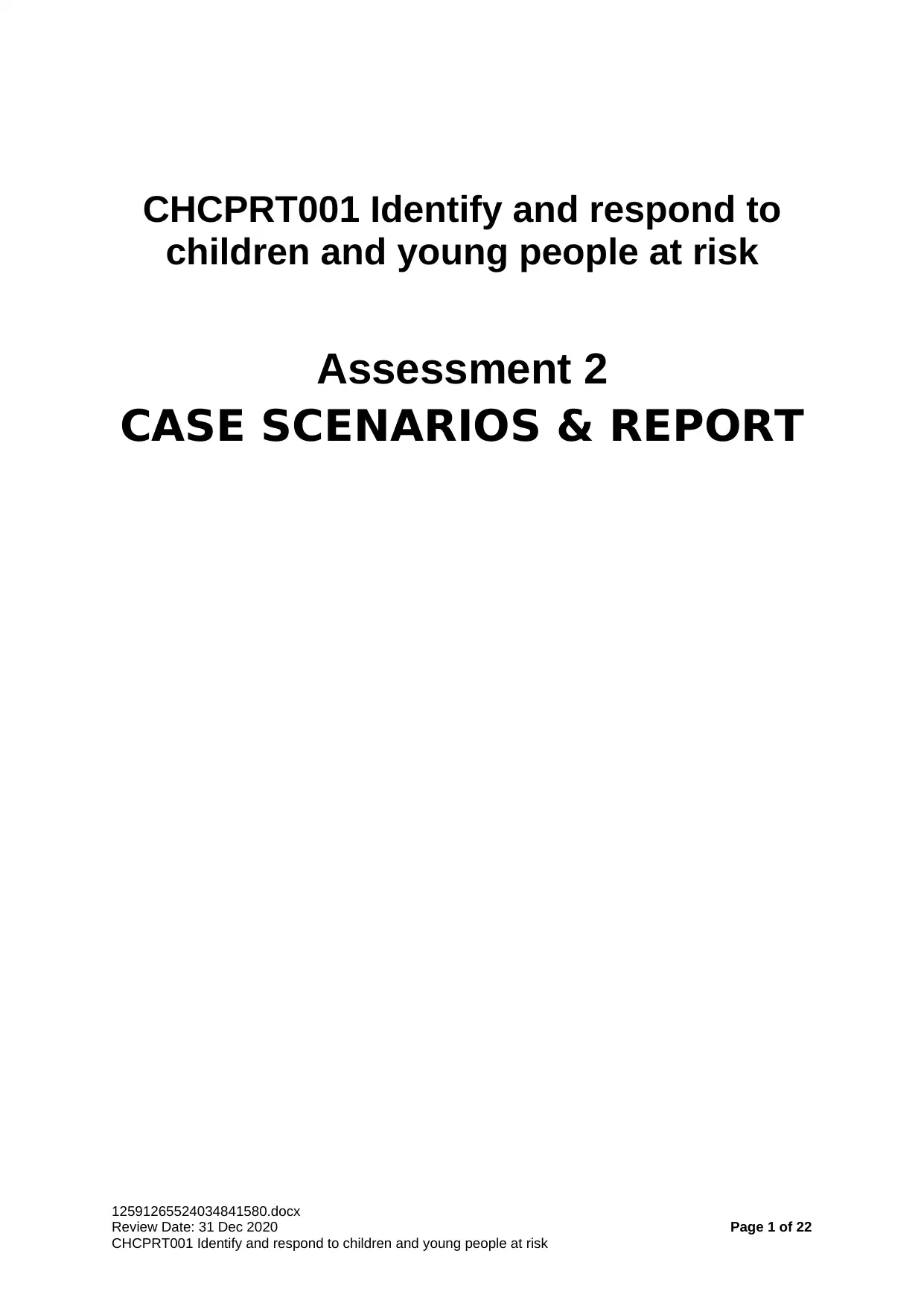
12591265524034841580.docx
Review Date: 31 Dec 2020 Page 1 of 22
CHCPRT001 Identify and respond to children and young people at risk
CHCPRT001 Identify and respond to
children and young people at risk
Assessment 2
CASE SCENARIOS & REPORT
Review Date: 31 Dec 2020 Page 1 of 22
CHCPRT001 Identify and respond to children and young people at risk
CHCPRT001 Identify and respond to
children and young people at risk
Assessment 2
CASE SCENARIOS & REPORT
Paraphrase This Document
Need a fresh take? Get an instant paraphrase of this document with our AI Paraphraser
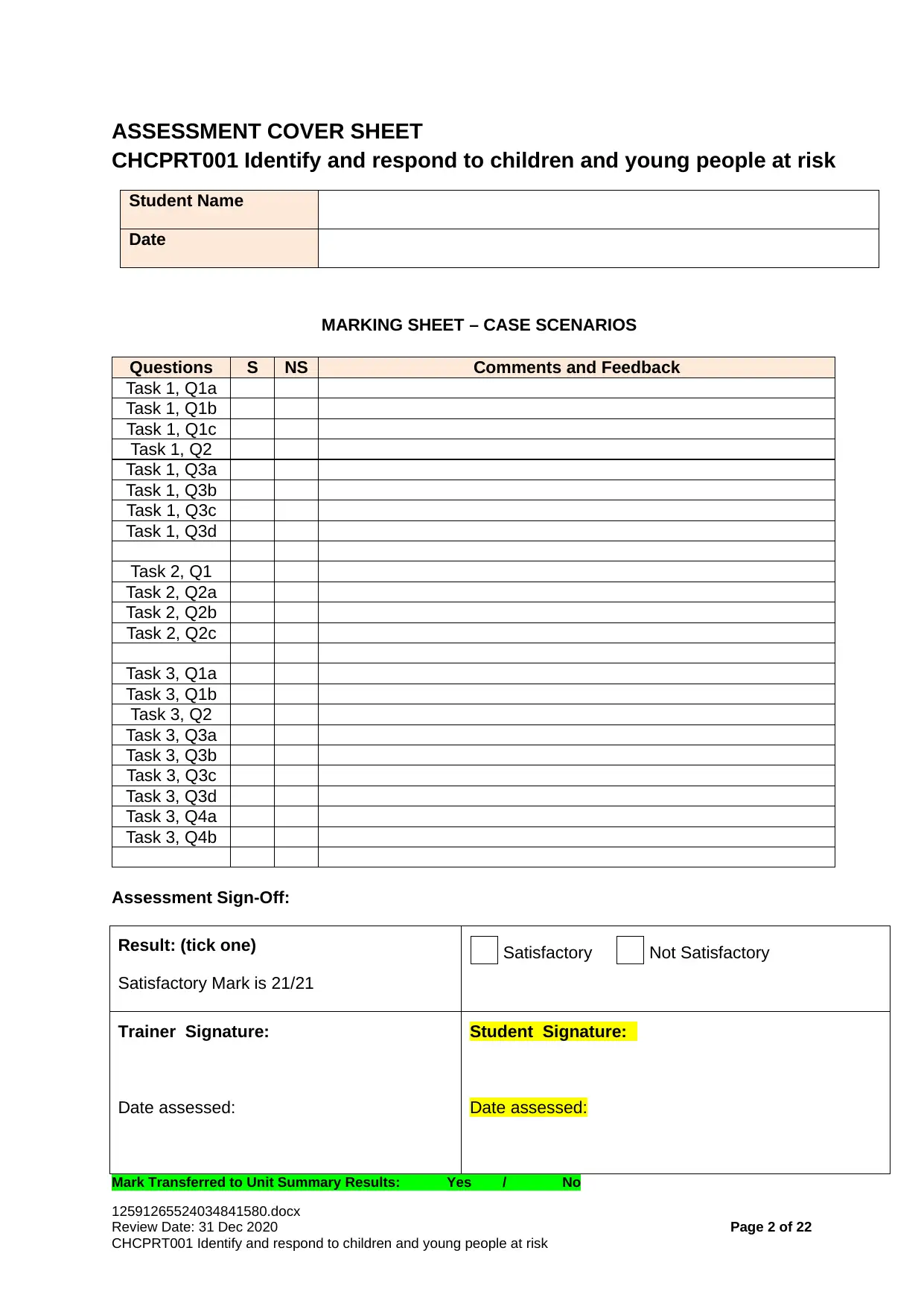
ASSESSMENT COVER SHEET
CHCPRT001 Identify and respond to children and young people at risk
Student Name
Date
MARKING SHEET – CASE SCENARIOS
Questions S NS Comments and Feedback
Task 1, Q1a
Task 1, Q1b
Task 1, Q1c
Task 1, Q2
Task 1, Q3a
Task 1, Q3b
Task 1, Q3c
Task 1, Q3d
Task 2, Q1
Task 2, Q2a
Task 2, Q2b
Task 2, Q2c
Task 3, Q1a
Task 3, Q1b
Task 3, Q2
Task 3, Q3a
Task 3, Q3b
Task 3, Q3c
Task 3, Q3d
Task 3, Q4a
Task 3, Q4b
Assessment Sign-Off:
Result: (tick one)
Satisfactory Mark is 21/21
Satisfactory Not Satisfactory
Trainer Signature:
Date assessed:
Student Signature:
Date assessed:
Mark Transferred to Unit Summary Results: Yes / No
12591265524034841580.docx
Review Date: 31 Dec 2020 Page 2 of 22
CHCPRT001 Identify and respond to children and young people at risk
CHCPRT001 Identify and respond to children and young people at risk
Student Name
Date
MARKING SHEET – CASE SCENARIOS
Questions S NS Comments and Feedback
Task 1, Q1a
Task 1, Q1b
Task 1, Q1c
Task 1, Q2
Task 1, Q3a
Task 1, Q3b
Task 1, Q3c
Task 1, Q3d
Task 2, Q1
Task 2, Q2a
Task 2, Q2b
Task 2, Q2c
Task 3, Q1a
Task 3, Q1b
Task 3, Q2
Task 3, Q3a
Task 3, Q3b
Task 3, Q3c
Task 3, Q3d
Task 3, Q4a
Task 3, Q4b
Assessment Sign-Off:
Result: (tick one)
Satisfactory Mark is 21/21
Satisfactory Not Satisfactory
Trainer Signature:
Date assessed:
Student Signature:
Date assessed:
Mark Transferred to Unit Summary Results: Yes / No
12591265524034841580.docx
Review Date: 31 Dec 2020 Page 2 of 22
CHCPRT001 Identify and respond to children and young people at risk
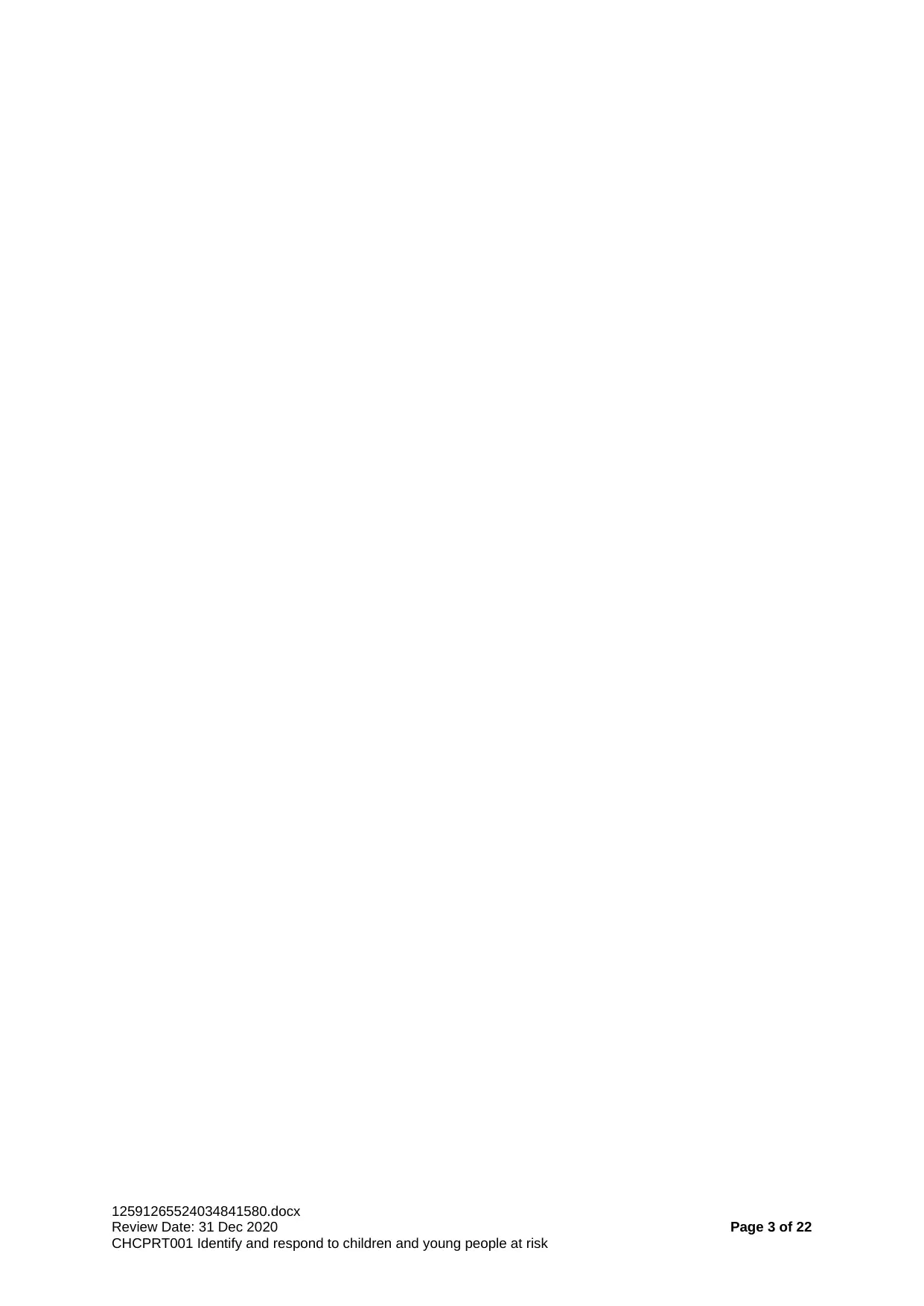
12591265524034841580.docx
Review Date: 31 Dec 2020 Page 3 of 22
CHCPRT001 Identify and respond to children and young people at risk
Review Date: 31 Dec 2020 Page 3 of 22
CHCPRT001 Identify and respond to children and young people at risk
⊘ This is a preview!⊘
Do you want full access?
Subscribe today to unlock all pages.

Trusted by 1+ million students worldwide
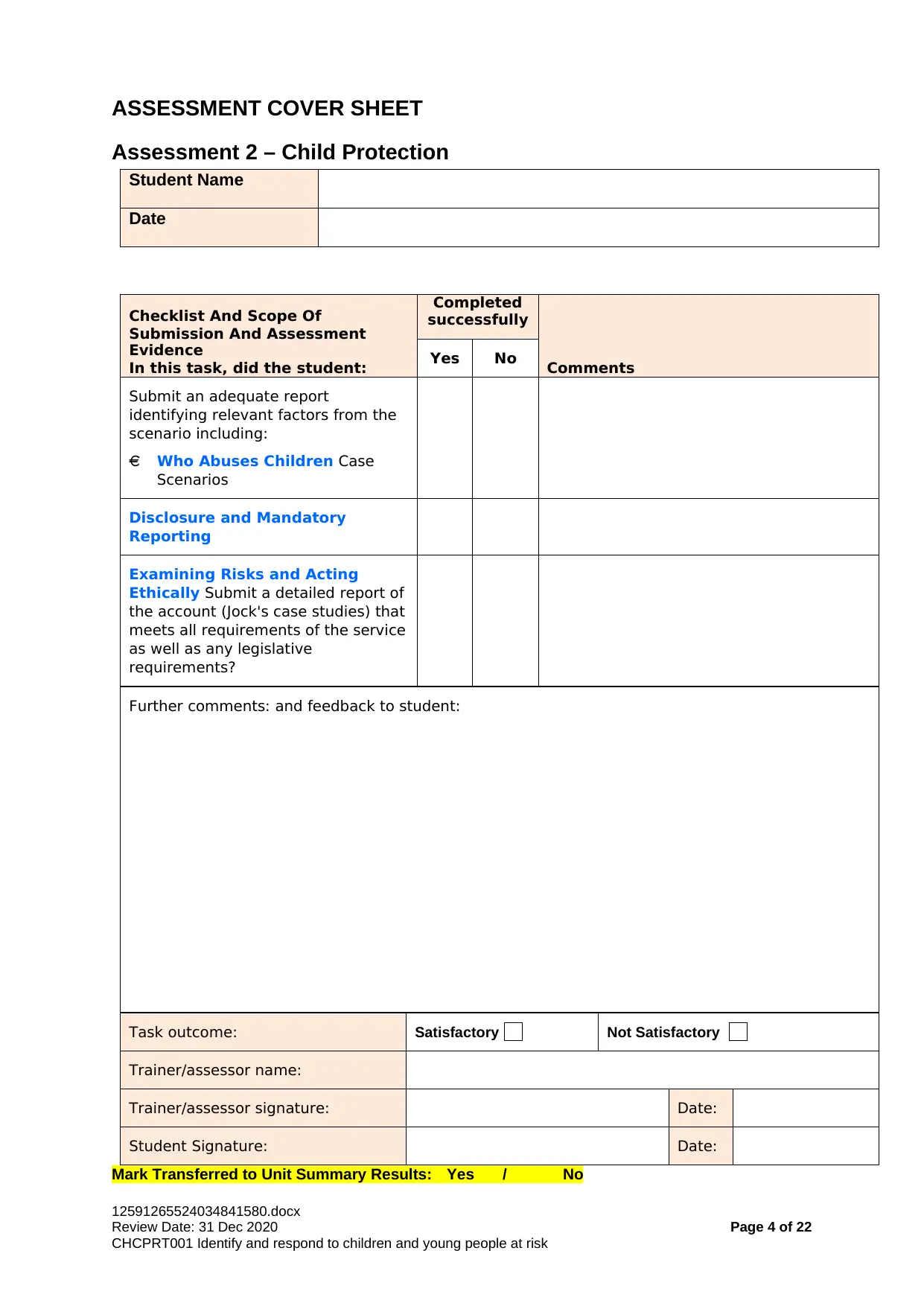
ASSESSMENT COVER SHEET
Assessment 2 – Child Protection
Student Name
Date
Checklist And Scope Of
Submission And Assessment
Evidence
In this task, did the student:
Completed
successfully
Comments
Yes No
Submit an adequate report
identifying relevant factors from the
scenario including:
Who Abuses Children Case
Scenarios
Disclosure and Mandatory
Reporting
Examining Risks and Acting
Ethically Submit a detailed report of
the account (Jock's case studies) that
meets all requirements of the service
as well as any legislative
requirements?
Further comments: and feedback to student:
Task outcome: Satisfactory Not Satisfactory
Trainer/assessor name:
Trainer/assessor signature: Date:
Student Signature: Date:
Mark Transferred to Unit Summary Results: Yes / No
12591265524034841580.docx
Review Date: 31 Dec 2020 Page 4 of 22
CHCPRT001 Identify and respond to children and young people at risk
Assessment 2 – Child Protection
Student Name
Date
Checklist And Scope Of
Submission And Assessment
Evidence
In this task, did the student:
Completed
successfully
Comments
Yes No
Submit an adequate report
identifying relevant factors from the
scenario including:
Who Abuses Children Case
Scenarios
Disclosure and Mandatory
Reporting
Examining Risks and Acting
Ethically Submit a detailed report of
the account (Jock's case studies) that
meets all requirements of the service
as well as any legislative
requirements?
Further comments: and feedback to student:
Task outcome: Satisfactory Not Satisfactory
Trainer/assessor name:
Trainer/assessor signature: Date:
Student Signature: Date:
Mark Transferred to Unit Summary Results: Yes / No
12591265524034841580.docx
Review Date: 31 Dec 2020 Page 4 of 22
CHCPRT001 Identify and respond to children and young people at risk
Paraphrase This Document
Need a fresh take? Get an instant paraphrase of this document with our AI Paraphraser
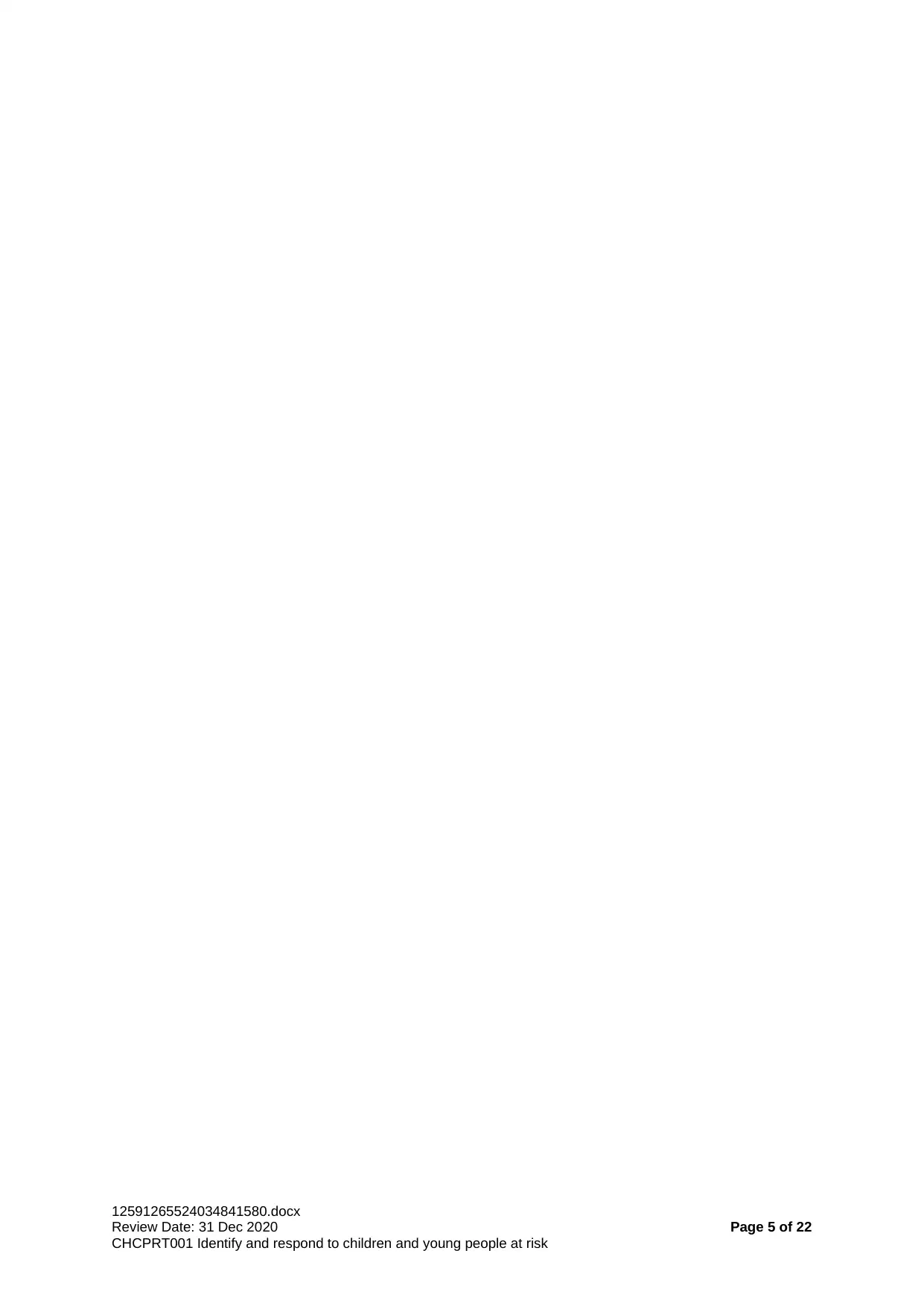
12591265524034841580.docx
Review Date: 31 Dec 2020 Page 5 of 22
CHCPRT001 Identify and respond to children and young people at risk
Review Date: 31 Dec 2020 Page 5 of 22
CHCPRT001 Identify and respond to children and young people at risk
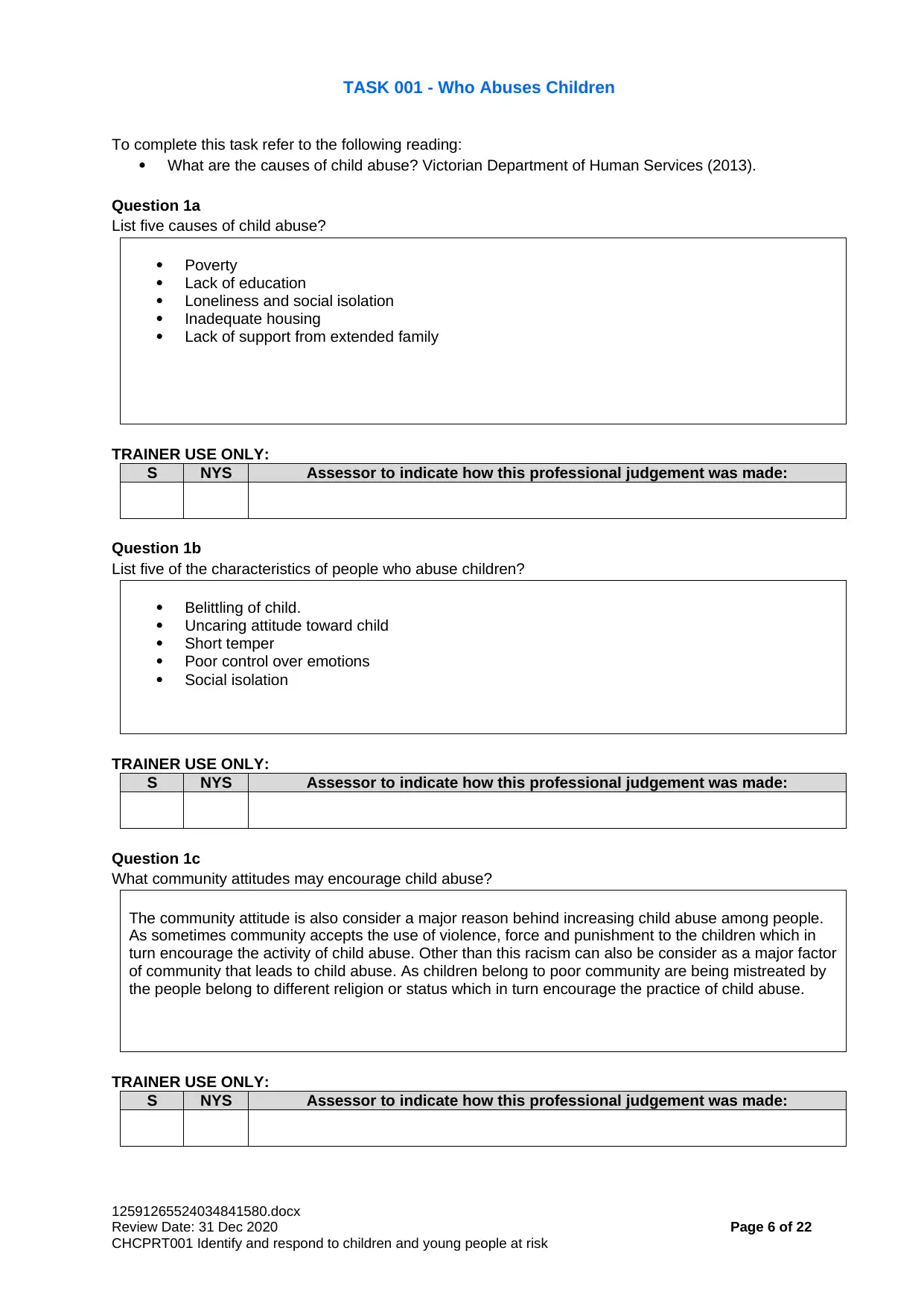
TASK 001 - Who Abuses Children
To complete this task refer to the following reading:
What are the causes of child abuse? Victorian Department of Human Services (2013).
Question 1a
List five causes of child abuse?
Poverty
Lack of education
Loneliness and social isolation
Inadequate housing
Lack of support from extended family
TRAINER USE ONLY:
S NYS Assessor to indicate how this professional judgement was made:
Question 1b
List five of the characteristics of people who abuse children?
Belittling of child.
Uncaring attitude toward child
Short temper
Poor control over emotions
Social isolation
TRAINER USE ONLY:
S NYS Assessor to indicate how this professional judgement was made:
Question 1c
What community attitudes may encourage child abuse?
The community attitude is also consider a major reason behind increasing child abuse among people.
As sometimes community accepts the use of violence, force and punishment to the children which in
turn encourage the activity of child abuse. Other than this racism can also be consider as a major factor
of community that leads to child abuse. As children belong to poor community are being mistreated by
the people belong to different religion or status which in turn encourage the practice of child abuse.
TRAINER USE ONLY:
S NYS Assessor to indicate how this professional judgement was made:
12591265524034841580.docx
Review Date: 31 Dec 2020 Page 6 of 22
CHCPRT001 Identify and respond to children and young people at risk
To complete this task refer to the following reading:
What are the causes of child abuse? Victorian Department of Human Services (2013).
Question 1a
List five causes of child abuse?
Poverty
Lack of education
Loneliness and social isolation
Inadequate housing
Lack of support from extended family
TRAINER USE ONLY:
S NYS Assessor to indicate how this professional judgement was made:
Question 1b
List five of the characteristics of people who abuse children?
Belittling of child.
Uncaring attitude toward child
Short temper
Poor control over emotions
Social isolation
TRAINER USE ONLY:
S NYS Assessor to indicate how this professional judgement was made:
Question 1c
What community attitudes may encourage child abuse?
The community attitude is also consider a major reason behind increasing child abuse among people.
As sometimes community accepts the use of violence, force and punishment to the children which in
turn encourage the activity of child abuse. Other than this racism can also be consider as a major factor
of community that leads to child abuse. As children belong to poor community are being mistreated by
the people belong to different religion or status which in turn encourage the practice of child abuse.
TRAINER USE ONLY:
S NYS Assessor to indicate how this professional judgement was made:
12591265524034841580.docx
Review Date: 31 Dec 2020 Page 6 of 22
CHCPRT001 Identify and respond to children and young people at risk
⊘ This is a preview!⊘
Do you want full access?
Subscribe today to unlock all pages.

Trusted by 1+ million students worldwide
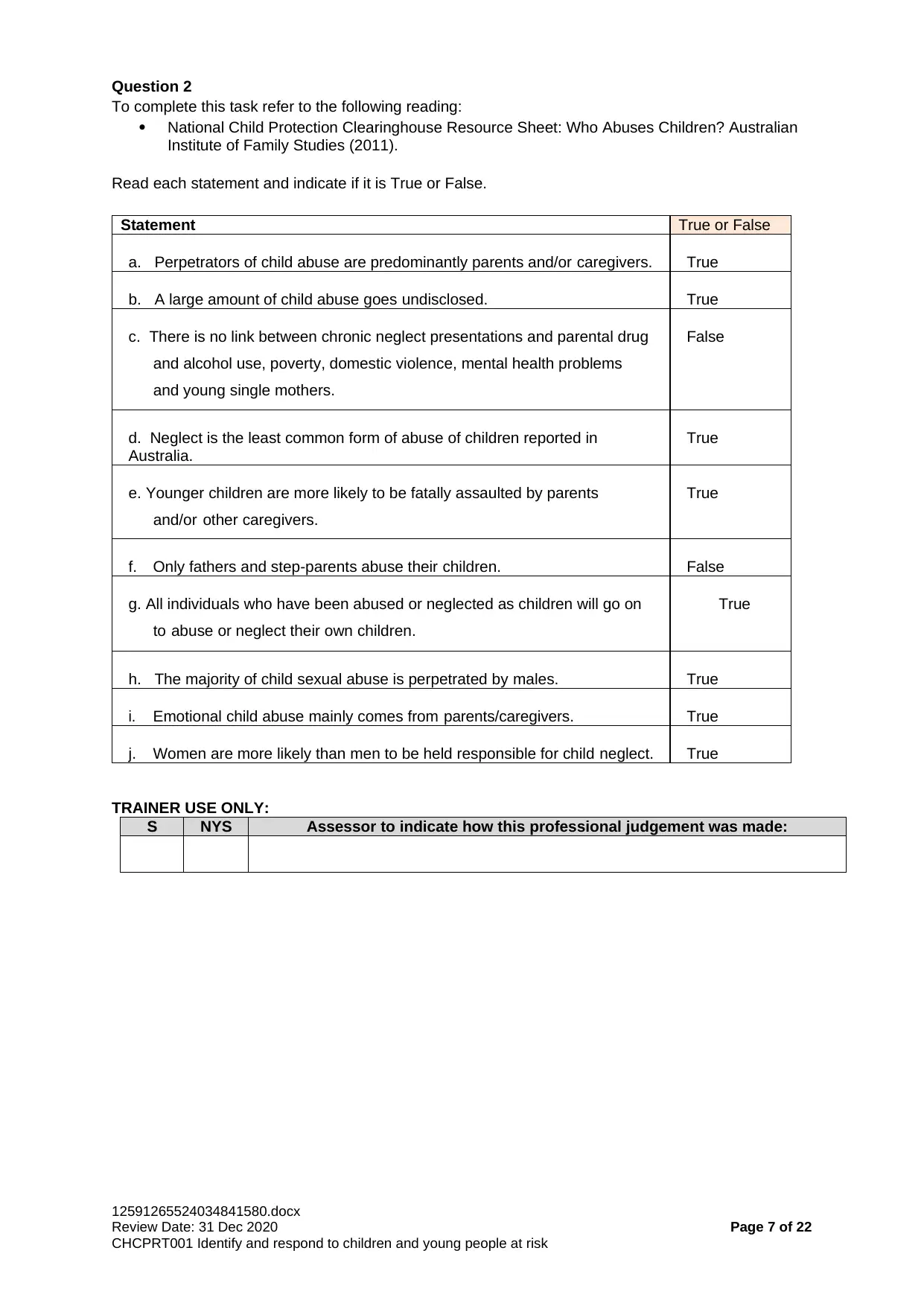
Question 2
To complete this task refer to the following reading:
National Child Protection Clearinghouse Resource Sheet: Who Abuses Children? Australian
Institute of Family Studies (2011).
Read each statement and indicate if it is True or False.
Statement True or False
a. Perpetrators of child abuse are predominantly parents and/or caregivers. True
b. A large amount of child abuse goes undisclosed. True
c. There is no link between chronic neglect presentations and parental drug
and alcohol use, poverty, domestic violence, mental health problems
and young single mothers.
False
d. Neglect is the least common form of abuse of children reported in
Australia.
True
e. Younger children are more likely to be fatally assaulted by parents
and/or other caregivers.
True
f. Only fathers and step-parents abuse their children. False
g. All individuals who have been abused or neglected as children will go on
to abuse or neglect their own children.
True
h. The majority of child sexual abuse is perpetrated by males. True
i. Emotional child abuse mainly comes from parents/caregivers. True
j. Women are more likely than men to be held responsible for child neglect. True
TRAINER USE ONLY:
S NYS Assessor to indicate how this professional judgement was made:
12591265524034841580.docx
Review Date: 31 Dec 2020 Page 7 of 22
CHCPRT001 Identify and respond to children and young people at risk
To complete this task refer to the following reading:
National Child Protection Clearinghouse Resource Sheet: Who Abuses Children? Australian
Institute of Family Studies (2011).
Read each statement and indicate if it is True or False.
Statement True or False
a. Perpetrators of child abuse are predominantly parents and/or caregivers. True
b. A large amount of child abuse goes undisclosed. True
c. There is no link between chronic neglect presentations and parental drug
and alcohol use, poverty, domestic violence, mental health problems
and young single mothers.
False
d. Neglect is the least common form of abuse of children reported in
Australia.
True
e. Younger children are more likely to be fatally assaulted by parents
and/or other caregivers.
True
f. Only fathers and step-parents abuse their children. False
g. All individuals who have been abused or neglected as children will go on
to abuse or neglect their own children.
True
h. The majority of child sexual abuse is perpetrated by males. True
i. Emotional child abuse mainly comes from parents/caregivers. True
j. Women are more likely than men to be held responsible for child neglect. True
TRAINER USE ONLY:
S NYS Assessor to indicate how this professional judgement was made:
12591265524034841580.docx
Review Date: 31 Dec 2020 Page 7 of 22
CHCPRT001 Identify and respond to children and young people at risk
Paraphrase This Document
Need a fresh take? Get an instant paraphrase of this document with our AI Paraphraser
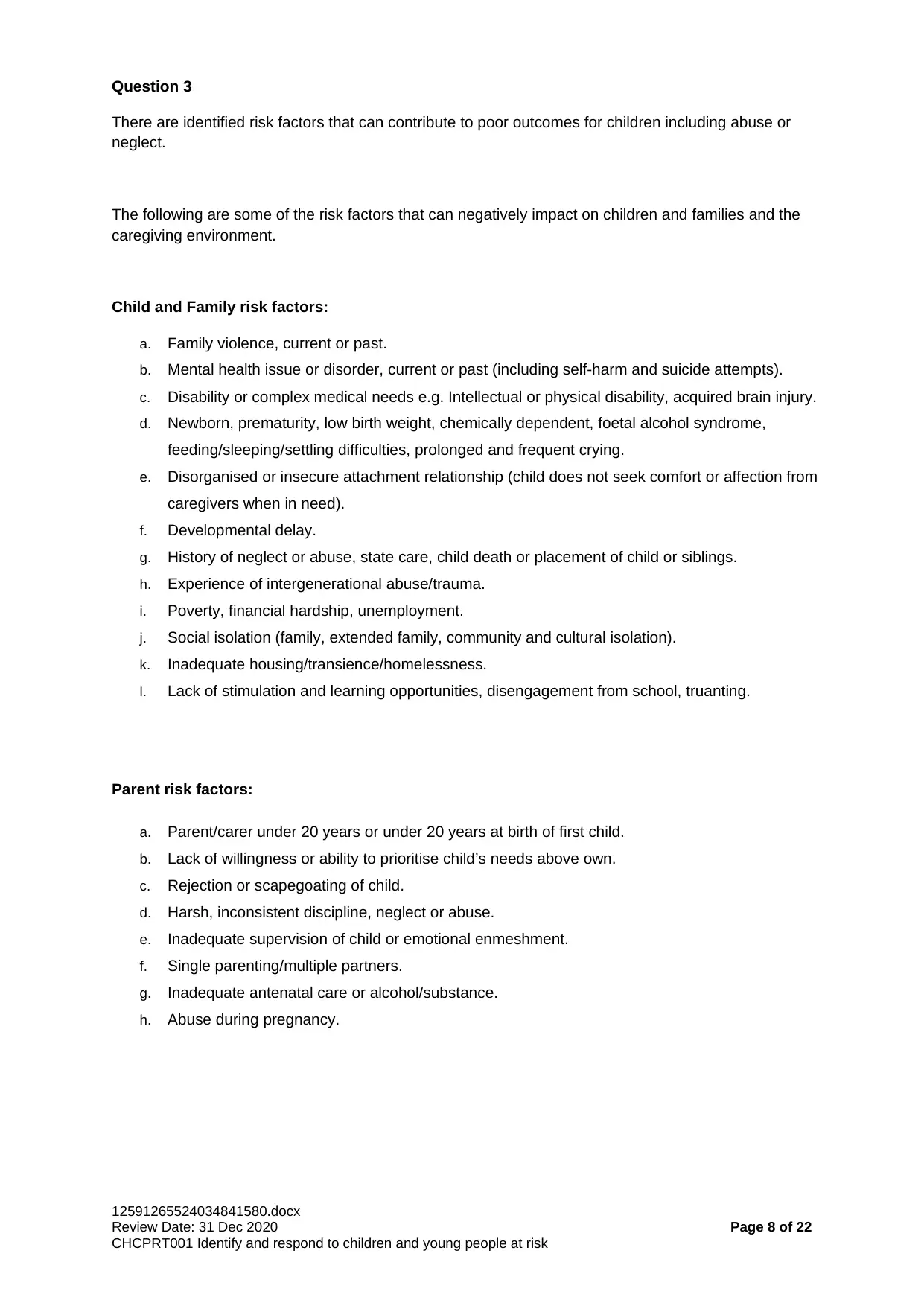
Question 3
There are identified risk factors that can contribute to poor outcomes for children including abuse or
neglect.
The following are some of the risk factors that can negatively impact on children and families and the
caregiving environment.
Child and Family risk factors:
a. Family violence, current or past.
b. Mental health issue or disorder, current or past (including self-harm and suicide attempts).
c. Disability or complex medical needs e.g. Intellectual or physical disability, acquired brain injury.
d. Newborn, prematurity, low birth weight, chemically dependent, foetal alcohol syndrome,
feeding/sleeping/settling difficulties, prolonged and frequent crying.
e. Disorganised or insecure attachment relationship (child does not seek comfort or affection from
caregivers when in need).
f. Developmental delay.
g. History of neglect or abuse, state care, child death or placement of child or siblings.
h. Experience of intergenerational abuse/trauma.
i. Poverty, financial hardship, unemployment.
j. Social isolation (family, extended family, community and cultural isolation).
k. Inadequate housing/transience/homelessness.
l. Lack of stimulation and learning opportunities, disengagement from school, truanting.
Parent risk factors:
a. Parent/carer under 20 years or under 20 years at birth of first child.
b. Lack of willingness or ability to prioritise child’s needs above own.
c. Rejection or scapegoating of child.
d. Harsh, inconsistent discipline, neglect or abuse.
e. Inadequate supervision of child or emotional enmeshment.
f. Single parenting/multiple partners.
g. Inadequate antenatal care or alcohol/substance.
h. Abuse during pregnancy.
12591265524034841580.docx
Review Date: 31 Dec 2020 Page 8 of 22
CHCPRT001 Identify and respond to children and young people at risk
There are identified risk factors that can contribute to poor outcomes for children including abuse or
neglect.
The following are some of the risk factors that can negatively impact on children and families and the
caregiving environment.
Child and Family risk factors:
a. Family violence, current or past.
b. Mental health issue or disorder, current or past (including self-harm and suicide attempts).
c. Disability or complex medical needs e.g. Intellectual or physical disability, acquired brain injury.
d. Newborn, prematurity, low birth weight, chemically dependent, foetal alcohol syndrome,
feeding/sleeping/settling difficulties, prolonged and frequent crying.
e. Disorganised or insecure attachment relationship (child does not seek comfort or affection from
caregivers when in need).
f. Developmental delay.
g. History of neglect or abuse, state care, child death or placement of child or siblings.
h. Experience of intergenerational abuse/trauma.
i. Poverty, financial hardship, unemployment.
j. Social isolation (family, extended family, community and cultural isolation).
k. Inadequate housing/transience/homelessness.
l. Lack of stimulation and learning opportunities, disengagement from school, truanting.
Parent risk factors:
a. Parent/carer under 20 years or under 20 years at birth of first child.
b. Lack of willingness or ability to prioritise child’s needs above own.
c. Rejection or scapegoating of child.
d. Harsh, inconsistent discipline, neglect or abuse.
e. Inadequate supervision of child or emotional enmeshment.
f. Single parenting/multiple partners.
g. Inadequate antenatal care or alcohol/substance.
h. Abuse during pregnancy.
12591265524034841580.docx
Review Date: 31 Dec 2020 Page 8 of 22
CHCPRT001 Identify and respond to children and young people at risk
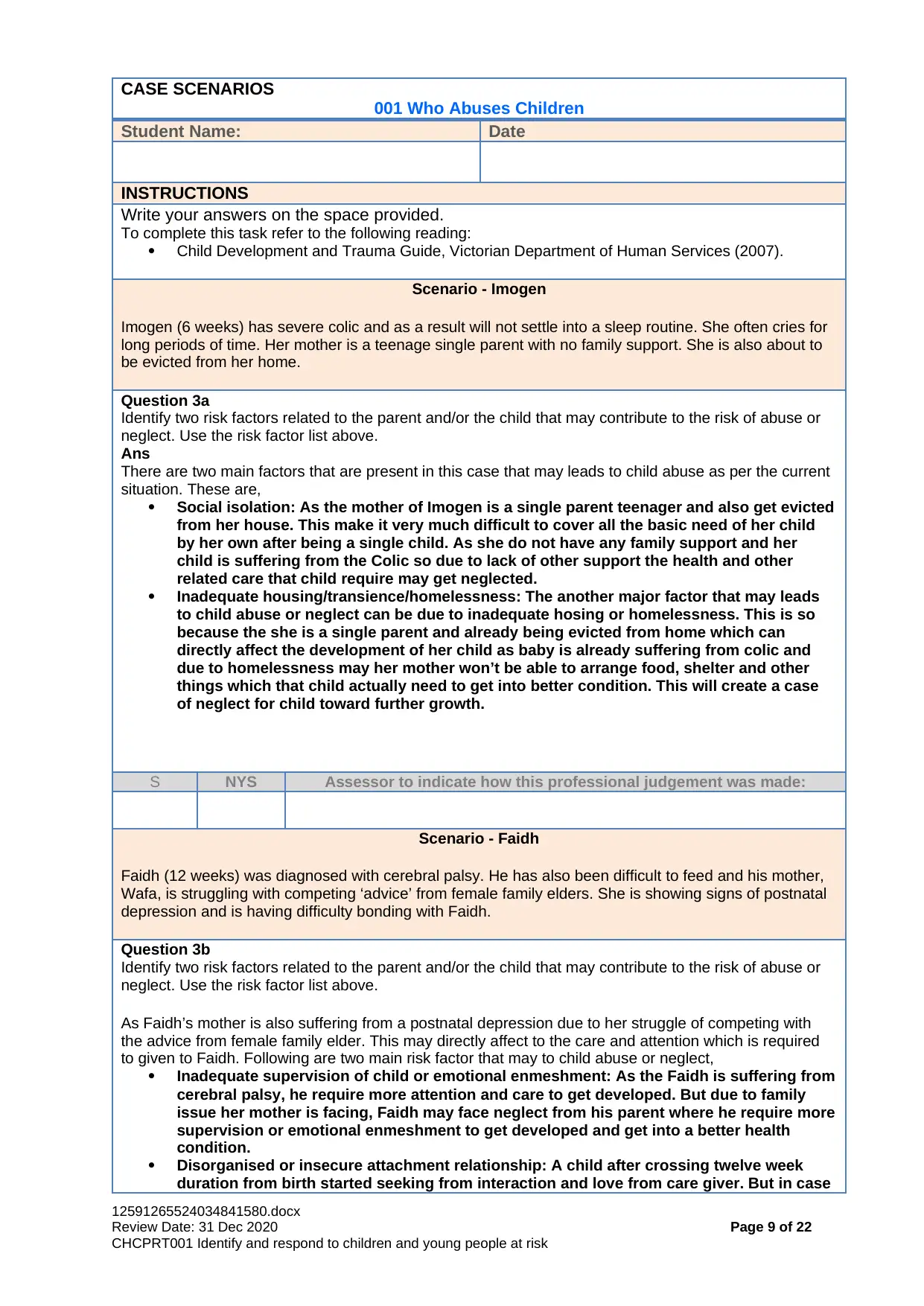
CASE SCENARIOS
001 Who Abuses Children
Student Name: Date
INSTRUCTIONS
Write your answers on the space provided.
To complete this task refer to the following reading:
Child Development and Trauma Guide, Victorian Department of Human Services (2007).
Scenario - Imogen
Imogen (6 weeks) has severe colic and as a result will not settle into a sleep routine. She often cries for
long periods of time. Her mother is a teenage single parent with no family support. She is also about to
be evicted from her home.
Question 3a
Identify two risk factors related to the parent and/or the child that may contribute to the risk of abuse or
neglect. Use the risk factor list above.
Ans
There are two main factors that are present in this case that may leads to child abuse as per the current
situation. These are,
Social isolation: As the mother of Imogen is a single parent teenager and also get evicted
from her house. This make it very much difficult to cover all the basic need of her child
by her own after being a single child. As she do not have any family support and her
child is suffering from the Colic so due to lack of other support the health and other
related care that child require may get neglected.
Inadequate housing/transience/homelessness: The another major factor that may leads
to child abuse or neglect can be due to inadequate hosing or homelessness. This is so
because the she is a single parent and already being evicted from home which can
directly affect the development of her child as baby is already suffering from colic and
due to homelessness may her mother won’t be able to arrange food, shelter and other
things which that child actually need to get into better condition. This will create a case
of neglect for child toward further growth.
S NYS Assessor to indicate how this professional judgement was made:
Scenario - Faidh
Faidh (12 weeks) was diagnosed with cerebral palsy. He has also been difficult to feed and his mother,
Wafa, is struggling with competing ‘advice’ from female family elders. She is showing signs of postnatal
depression and is having difficulty bonding with Faidh.
Question 3b
Identify two risk factors related to the parent and/or the child that may contribute to the risk of abuse or
neglect. Use the risk factor list above.
As Faidh’s mother is also suffering from a postnatal depression due to her struggle of competing with
the advice from female family elder. This may directly affect to the care and attention which is required
to given to Faidh. Following are two main risk factor that may to child abuse or neglect,
Inadequate supervision of child or emotional enmeshment: As the Faidh is suffering from
cerebral palsy, he require more attention and care to get developed. But due to family
issue her mother is facing, Faidh may face neglect from his parent where he require more
supervision or emotional enmeshment to get developed and get into a better health
condition.
Disorganised or insecure attachment relationship: A child after crossing twelve week
duration from birth started seeking from interaction and love from care giver. But in case
12591265524034841580.docx
Review Date: 31 Dec 2020 Page 9 of 22
CHCPRT001 Identify and respond to children and young people at risk
001 Who Abuses Children
Student Name: Date
INSTRUCTIONS
Write your answers on the space provided.
To complete this task refer to the following reading:
Child Development and Trauma Guide, Victorian Department of Human Services (2007).
Scenario - Imogen
Imogen (6 weeks) has severe colic and as a result will not settle into a sleep routine. She often cries for
long periods of time. Her mother is a teenage single parent with no family support. She is also about to
be evicted from her home.
Question 3a
Identify two risk factors related to the parent and/or the child that may contribute to the risk of abuse or
neglect. Use the risk factor list above.
Ans
There are two main factors that are present in this case that may leads to child abuse as per the current
situation. These are,
Social isolation: As the mother of Imogen is a single parent teenager and also get evicted
from her house. This make it very much difficult to cover all the basic need of her child
by her own after being a single child. As she do not have any family support and her
child is suffering from the Colic so due to lack of other support the health and other
related care that child require may get neglected.
Inadequate housing/transience/homelessness: The another major factor that may leads
to child abuse or neglect can be due to inadequate hosing or homelessness. This is so
because the she is a single parent and already being evicted from home which can
directly affect the development of her child as baby is already suffering from colic and
due to homelessness may her mother won’t be able to arrange food, shelter and other
things which that child actually need to get into better condition. This will create a case
of neglect for child toward further growth.
S NYS Assessor to indicate how this professional judgement was made:
Scenario - Faidh
Faidh (12 weeks) was diagnosed with cerebral palsy. He has also been difficult to feed and his mother,
Wafa, is struggling with competing ‘advice’ from female family elders. She is showing signs of postnatal
depression and is having difficulty bonding with Faidh.
Question 3b
Identify two risk factors related to the parent and/or the child that may contribute to the risk of abuse or
neglect. Use the risk factor list above.
As Faidh’s mother is also suffering from a postnatal depression due to her struggle of competing with
the advice from female family elder. This may directly affect to the care and attention which is required
to given to Faidh. Following are two main risk factor that may to child abuse or neglect,
Inadequate supervision of child or emotional enmeshment: As the Faidh is suffering from
cerebral palsy, he require more attention and care to get developed. But due to family
issue her mother is facing, Faidh may face neglect from his parent where he require more
supervision or emotional enmeshment to get developed and get into a better health
condition.
Disorganised or insecure attachment relationship: A child after crossing twelve week
duration from birth started seeking from interaction and love from care giver. But in case
12591265524034841580.docx
Review Date: 31 Dec 2020 Page 9 of 22
CHCPRT001 Identify and respond to children and young people at risk
⊘ This is a preview!⊘
Do you want full access?
Subscribe today to unlock all pages.

Trusted by 1+ million students worldwide
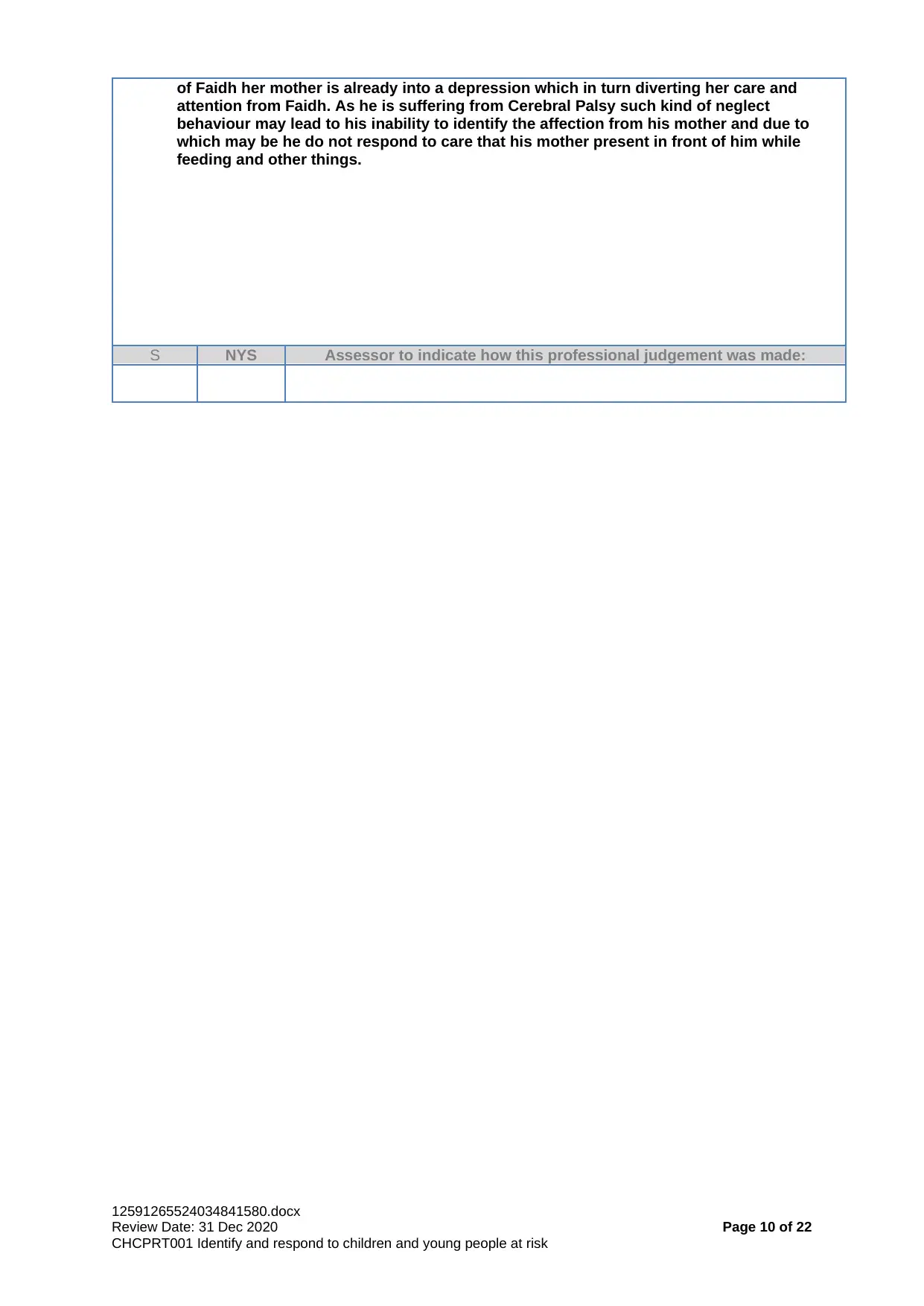
of Faidh her mother is already into a depression which in turn diverting her care and
attention from Faidh. As he is suffering from Cerebral Palsy such kind of neglect
behaviour may lead to his inability to identify the affection from his mother and due to
which may be he do not respond to care that his mother present in front of him while
feeding and other things.
S NYS Assessor to indicate how this professional judgement was made:
12591265524034841580.docx
Review Date: 31 Dec 2020 Page 10 of 22
CHCPRT001 Identify and respond to children and young people at risk
attention from Faidh. As he is suffering from Cerebral Palsy such kind of neglect
behaviour may lead to his inability to identify the affection from his mother and due to
which may be he do not respond to care that his mother present in front of him while
feeding and other things.
S NYS Assessor to indicate how this professional judgement was made:
12591265524034841580.docx
Review Date: 31 Dec 2020 Page 10 of 22
CHCPRT001 Identify and respond to children and young people at risk
Paraphrase This Document
Need a fresh take? Get an instant paraphrase of this document with our AI Paraphraser
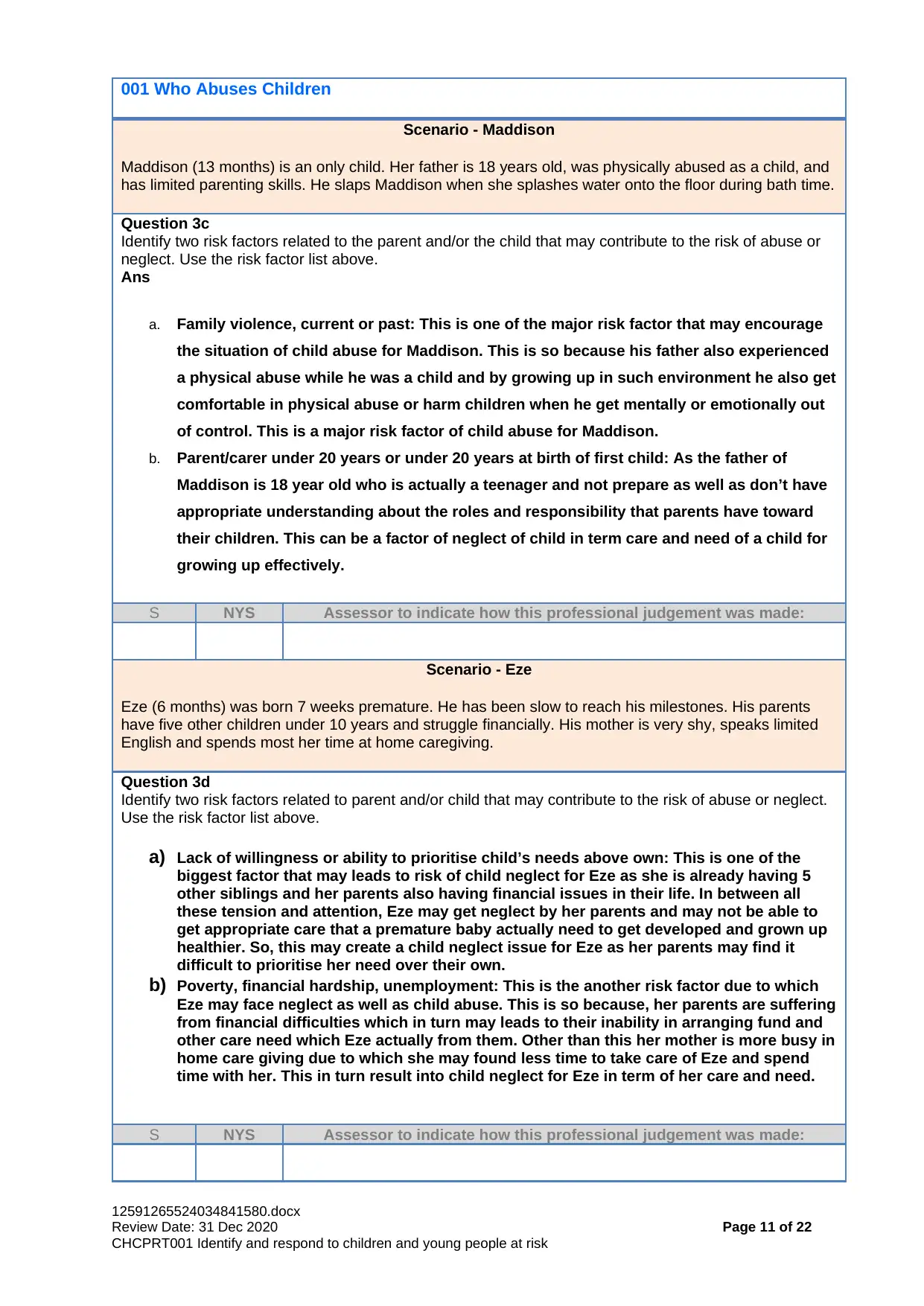
001 Who Abuses Children
Scenario - Maddison
Maddison (13 months) is an only child. Her father is 18 years old, was physically abused as a child, and
has limited parenting skills. He slaps Maddison when she splashes water onto the floor during bath time.
Question 3c
Identify two risk factors related to the parent and/or the child that may contribute to the risk of abuse or
neglect. Use the risk factor list above.
Ans
a. Family violence, current or past: This is one of the major risk factor that may encourage
the situation of child abuse for Maddison. This is so because his father also experienced
a physical abuse while he was a child and by growing up in such environment he also get
comfortable in physical abuse or harm children when he get mentally or emotionally out
of control. This is a major risk factor of child abuse for Maddison.
b. Parent/carer under 20 years or under 20 years at birth of first child: As the father of
Maddison is 18 year old who is actually a teenager and not prepare as well as don’t have
appropriate understanding about the roles and responsibility that parents have toward
their children. This can be a factor of neglect of child in term care and need of a child for
growing up effectively.
S NYS Assessor to indicate how this professional judgement was made:
Scenario - Eze
Eze (6 months) was born 7 weeks premature. He has been slow to reach his milestones. His parents
have five other children under 10 years and struggle financially. His mother is very shy, speaks limited
English and spends most her time at home caregiving.
Question 3d
Identify two risk factors related to parent and/or child that may contribute to the risk of abuse or neglect.
Use the risk factor list above.
a) Lack of willingness or ability to prioritise child’s needs above own: This is one of the
biggest factor that may leads to risk of child neglect for Eze as she is already having 5
other siblings and her parents also having financial issues in their life. In between all
these tension and attention, Eze may get neglect by her parents and may not be able to
get appropriate care that a premature baby actually need to get developed and grown up
healthier. So, this may create a child neglect issue for Eze as her parents may find it
difficult to prioritise her need over their own.
b) Poverty, financial hardship, unemployment: This is the another risk factor due to which
Eze may face neglect as well as child abuse. This is so because, her parents are suffering
from financial difficulties which in turn may leads to their inability in arranging fund and
other care need which Eze actually from them. Other than this her mother is more busy in
home care giving due to which she may found less time to take care of Eze and spend
time with her. This in turn result into child neglect for Eze in term of her care and need.
S NYS Assessor to indicate how this professional judgement was made:
12591265524034841580.docx
Review Date: 31 Dec 2020 Page 11 of 22
CHCPRT001 Identify and respond to children and young people at risk
Scenario - Maddison
Maddison (13 months) is an only child. Her father is 18 years old, was physically abused as a child, and
has limited parenting skills. He slaps Maddison when she splashes water onto the floor during bath time.
Question 3c
Identify two risk factors related to the parent and/or the child that may contribute to the risk of abuse or
neglect. Use the risk factor list above.
Ans
a. Family violence, current or past: This is one of the major risk factor that may encourage
the situation of child abuse for Maddison. This is so because his father also experienced
a physical abuse while he was a child and by growing up in such environment he also get
comfortable in physical abuse or harm children when he get mentally or emotionally out
of control. This is a major risk factor of child abuse for Maddison.
b. Parent/carer under 20 years or under 20 years at birth of first child: As the father of
Maddison is 18 year old who is actually a teenager and not prepare as well as don’t have
appropriate understanding about the roles and responsibility that parents have toward
their children. This can be a factor of neglect of child in term care and need of a child for
growing up effectively.
S NYS Assessor to indicate how this professional judgement was made:
Scenario - Eze
Eze (6 months) was born 7 weeks premature. He has been slow to reach his milestones. His parents
have five other children under 10 years and struggle financially. His mother is very shy, speaks limited
English and spends most her time at home caregiving.
Question 3d
Identify two risk factors related to parent and/or child that may contribute to the risk of abuse or neglect.
Use the risk factor list above.
a) Lack of willingness or ability to prioritise child’s needs above own: This is one of the
biggest factor that may leads to risk of child neglect for Eze as she is already having 5
other siblings and her parents also having financial issues in their life. In between all
these tension and attention, Eze may get neglect by her parents and may not be able to
get appropriate care that a premature baby actually need to get developed and grown up
healthier. So, this may create a child neglect issue for Eze as her parents may find it
difficult to prioritise her need over their own.
b) Poverty, financial hardship, unemployment: This is the another risk factor due to which
Eze may face neglect as well as child abuse. This is so because, her parents are suffering
from financial difficulties which in turn may leads to their inability in arranging fund and
other care need which Eze actually from them. Other than this her mother is more busy in
home care giving due to which she may found less time to take care of Eze and spend
time with her. This in turn result into child neglect for Eze in term of her care and need.
S NYS Assessor to indicate how this professional judgement was made:
12591265524034841580.docx
Review Date: 31 Dec 2020 Page 11 of 22
CHCPRT001 Identify and respond to children and young people at risk
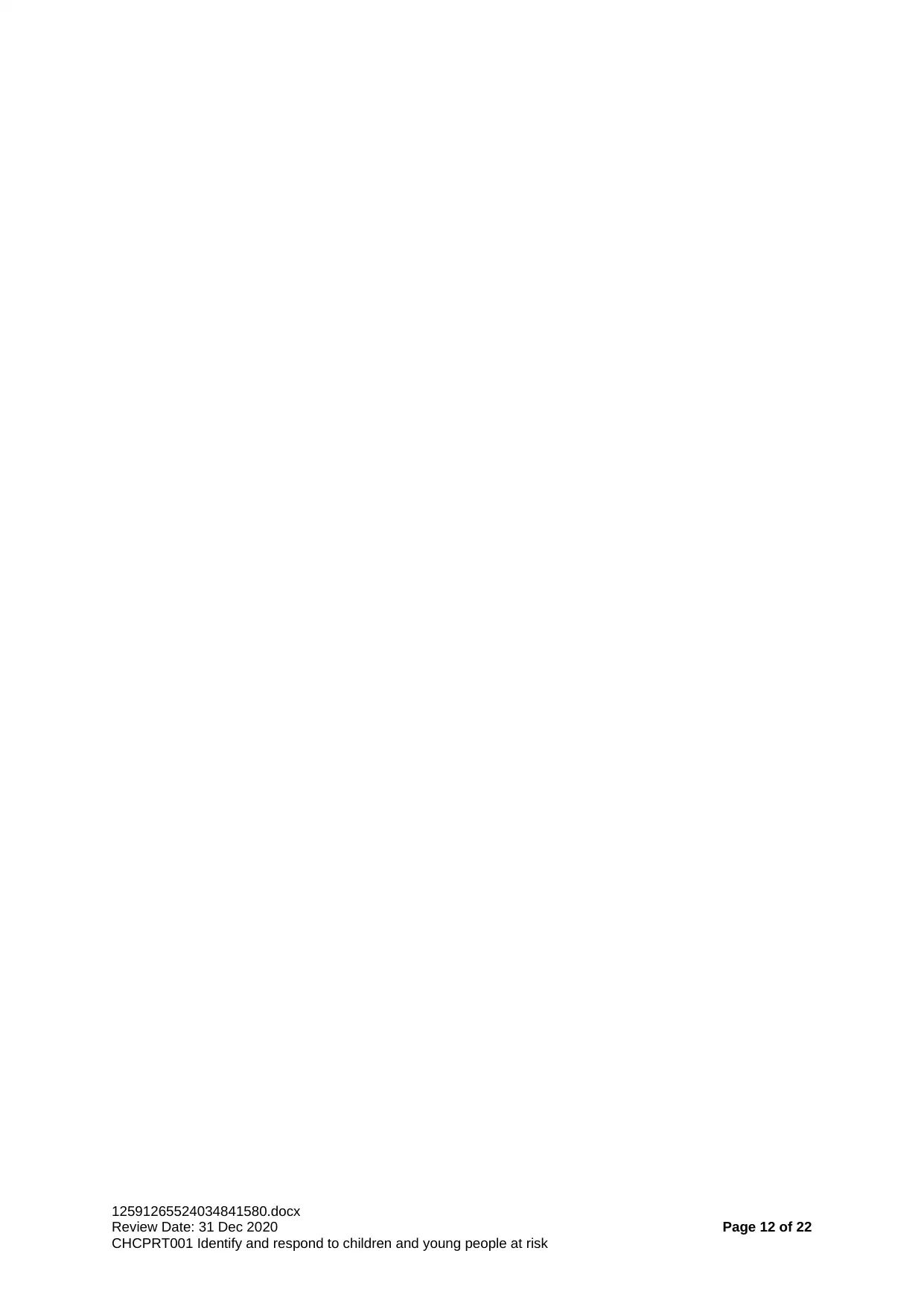
12591265524034841580.docx
Review Date: 31 Dec 2020 Page 12 of 22
CHCPRT001 Identify and respond to children and young people at risk
Review Date: 31 Dec 2020 Page 12 of 22
CHCPRT001 Identify and respond to children and young people at risk
⊘ This is a preview!⊘
Do you want full access?
Subscribe today to unlock all pages.

Trusted by 1+ million students worldwide
1 out of 22
Related Documents
Your All-in-One AI-Powered Toolkit for Academic Success.
+13062052269
info@desklib.com
Available 24*7 on WhatsApp / Email
![[object Object]](/_next/static/media/star-bottom.7253800d.svg)
Unlock your academic potential
Copyright © 2020–2025 A2Z Services. All Rights Reserved. Developed and managed by ZUCOL.





